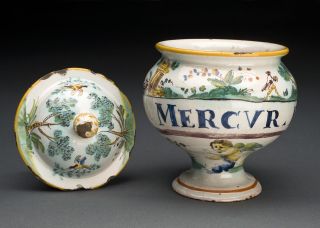Psychopharmacology
Heavy Metal Blues: The History of Medicinal Mercury
Concerns about mercury's toxic effects go back to antiquity.
Updated January 31, 2024 Reviewed by Lybi Ma
Key points
- The medicinal use of mercury, and recognition of its toxicity, go back to China in the third century BC.
- It was used in classical Greece and the West through medieval times for melancholy.
- Mercury toxicity may have affected figures including Abraham Lincoln, Edgar Allan Poe, and Louisa May Alcott.
In my research on the history of psychiatry and psychopharmacology, I can’t get away from mercury. Edgar Allan Poe, three months before he died in a delirious state, had been treated with mercury-laden calomel pills after exposure to cholera during an outbreak in Philadelphia; high levels were later found in samples of his hair. Although the possible contributory effects on Poe's condition are uncertain, some researchers suspect that figures as diverse as Abraham Lincoln, Charles Darwin, and Louisa May Alcott may have manifested symptoms of mercury toxicity. Since ancient times, mercury has been considered to be helpful for depression, and conversely, in relatively recent times environmental mercury—and even dental fillings containing it—has been suspected to be a cause of mood disorders.

The history of mercury as a medicine—and awareness of its toxicity in higher quantities—goes back to antiquity in Egypt and China. Qin Shi Huang, a Chinese emperor of the third century BC, whose physicians fed him large amounts as the key to immortality, reportedly went mad and suffered an early death at age 49. Even in the end, he was a believer; he was buried in a bejeweled tomb with mercury pools, which to this day cannot be opened because of concerns of toxic contamination.
Cinnabar (mercury sulfide), the ore from which most pure mercury is extracted, has had a place in Chinese traditional medicine for sedation for over 2000 years. It was widely used by the classical Greeks and throughout the Western world through medieval times for a variety of conditions including melancholy, venereal diseases, parasites, trachoma, and constipation. Mercury turned the stools black, and it was thought that this resulted from removing an excess of bile, one of the four ‘humors’ whose appropriate balance was believed to be important to health. On the contrary, toxic doses can cause difficulties with vision and hearing, kidney complications, peeling skin, itching or burning feelings of the limbs due to nerve damage, and memory disturbances; up to three-quarters of patients may display various degrees of depressive symptoms.
Both topical and oral forms of mercury were a mainstay in the treatment of syphilis, which had become widespread in Europe by the end of the fifteenth century. Calomel, a mercury chloride preparation, was in widespread use from the sixteenth until the twentieth century, as a cathartic, as well as for syphilis, typhoid fever, mumps, and a variety of other conditions. The administration for syphilis was immortalized in a famous saying: "A night with Venus, and a lifetime with mercury." Benjamin Rush, a physician and politician who had signed the Declaration of Independence, advocated calomel for mental disorders, as well as for yellow fever when it became widespread in Philadelphia in the late eighteenth century. Abraham Lincoln in his pre-presidential years took blue mass mercury pills (the reason is not entirely clear, but may have involved headaches, depression, and constipation).
In those days, the usual amount of mercury contained in blue mass was roughly one hundred times the current EPA guidelines. Some authors have suspected that one aspect of Lincoln’s severe depression and fits of anger, as well as physical symptoms such as difficulty walking and tremors, may have been toxic consequences. Lincoln may have seen the connection and decreased or stopped its use after the election. During the Civil War, William A. Hammond, the Union Army Surgeon General, advocated limiting the administration of calomel to the troops. He believed that adding dehydration from its cathartic properties, as well as the risk of mercury toxicity, was not of benefit to already-ill soldiers. He became very unpopular with army physicians, who, having few other remedies available, staged a calomel rebellion, and ultimately he was fired. In retrospect, this may have had a silver lining: he moved to New York, became one of the first American physicians to specialize in mental disorders, and in 1871 reported using lithium bromide as a treatment for manic episodes.
Another notable figure whose history was entwined with mercury was the poet Louisa May Alcott, who served as a nurse caring for Union soldiers in the Civil War. While doing so, she contracted typhoid in 1863 and was treated with calomel, ultimately becoming stuporous and plagued with hallucinations. She never fully regained her health, manifesting a variety of symptoms including skin rashes, musculoskeletal pain, gastrointestinal disturbances, and headaches, She died in 1888, believing that her affliction was due to mercury poisoning, though some retrospective medical analyses have disagreed.
Mercury had a place in the popular imagination as well. In Jules Verne’s 1871 novel 20,000 Leagues Under the Sea, the submarine Nautilus was powered by batteries containing mercury in combination with sodium from seawater. The mad hatter in Lewis Carroll’s Alice’s Adventures in Wonderland may have been a reference to the frequent neurological and psychiatric symptoms appearing in Victorian hat-makers, who used mercuric nitrate in the process of making felt from fur.
In the late nineteenth and first half of the twentieth centuries, mercury found wider and wider uses. The colorful bottles of liquids typical of apothecary’s windows usually contained calomel, mercury oxide, cinnabar, or related compounds.
Mercury products were widely used during both world wars, both as components of cartridge primers and blasting caps, but also as wound antiseptics. Organic preparations of mercury were developed in the 1920s and widely given as diuretics until the advent of thiazides in the 1950s. Mercurochrome, an organic preparation, was a common over-the-counter antiseptic and is still used in some parts of the world though no longer in the U.S. Thiomersal, a mercury-based preservative, widely used in vaccines, became a subject of controversy and was removed from children’s vaccines in the U.S. in 2001.
Today, concerns are still raised about the health consequences of the accumulation of mercury in the body. Among these have been reports of mood changes in dentists exposed to low levels of mercury while working with dental amalgams (1), and disorders of the cardiovascular and immunological systems, as well as depression, in patients receiving them (2). Although a 2013 treaty among 145 countries was designed to greatly limit the commercial use of mercury, it is still widely used illegally in gold mining in the third world, where it has been associated with developmental and neurological disorders (3).
As we look at these newer issues, it is helpful to remember that the concerns about mercury toxicity are not new, indeed going back to antiquity, and were quite prominent in the nineteenth century.
References
1. Heyer, N.J. et al.: Chronic low-level mercury exposure, BDNF polymorphism, and associations with self-reported symptoms and mood. Toxicological Sci. 81(2): 354-363, 2004.
2. Siblerud, R. and Mutter, J.: An overview of evidence that mercury from dental filling may be an etiological factor in many health disorders. J. Biomed. Res. Environ. Sci. 2(6): 472-485, 2021.
3. Federl, F. and Nicas, J.: Gold's deadly truth: much is mined with mercury. The New York Times, Sept. 22, 2023.




